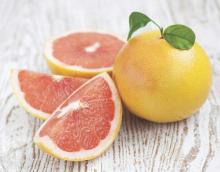The flavanone naringenin (5,7,4-trihydroxyflavanone) is known to exhibit anticarcinogenic, antioxidative, antiatherogenic, estrogenic, and immunomodulatory activity (Nutr. Cancer. 2012;64:714-24; J. Nutr. 2001;131:235-41; Life Sci. 2013;93:516-24). Naringenin can be found in high concentrations in grapefruits, oranges, and other citrus fruits as well as tomatoes (skin), with grapefruit juice found to yield much higher levels in plasma than orange juice (J. Nutr. 2001;131:235-41; Am. J. Physiol. Gastrointest. Liver Physiol. 2000;279:G1148-54; Nutr. Cancer 2012;64:714-24). Naringenin has been shown, along with other flavanones such as hesperetin and ponciretin, to strongly inhibit IgE-induced beta-hexosaminidase release from RBL-2H3 cells. Sung-Hwan Park and associates have suggested that the glycosides of these substances have potential as agents for treating IgE-induced atopic allergies (Planta Med. 2005;71:24-7).
In 2012, Kushi Anand and associates also showed that the combination of curcumin and naringenin exerted antiangiogenic and antitumor effects in Swiss albino mice, adding that neither compound has been associated with reports of toxicity in animals or humans (Nutr. Cancer 2012;64:714-24).
Potential cutaneous benefits
Tae-Ho Kim and colleagues studied the effects of naringenin on 2,4-dinitrofluorobenzene (DNFB)-induced atomic dermatitis in NC/Nga mice in 2013. After repetitive skin contact with DNFB, mice received intraperitoneal injections of naringenin for 1 week, with the treatment with the fruit flavonoid significantly diminishing ear swelling and back skin lesions. The flavonoid also significantly inhibited interferon (IFN)-alpha production by activated CD4+ T cells and lowered serum IgE levels as well as DNFB-induced infiltration of eosinophils, mast cells, CD4+ T cells, and CD8+ T cells in skin lesions (Life Sci. 2013;93:516-24).
Also that year, a naringenin glucoside (naringenin-7-O-glucoside) was found in an industrial blanch water extract, a byproduct of almond processing, and believed to play a role in exerting or contributing to a photoprotective effect in a small in vivo study with 12 volunteers (Molecules 2013;18:12426-40).
In 2014, K. Murata and associates screened several Prunus species in a search for skin-whitening compounds. Using an antityrosinase assay, the investigators determined that P. persica exhibited the greatest inhibitory activity and, in additional evaluation, it was found to hinder melanogenesis in B16 rat melanoma cells. Further, they identified afzelin (3-O-alpha-L-rhamnosylkaempferol) and the flavanone naringenin as the active ingredients responsible for inhibition of tyrosinase and melanogenesis and concluded that these substances warrant attention as potential skin-whitening agents (Nat. Prod. Commun. 2014;9:185-8).
A 2014 study in the ophthalmologic literature may also shed light on the photoprotective properties of naringenin. Jun-Li Lin and colleagues, studying the effects of the flavanone in eye drops used to treat N-methyl-N-nitrosourea (MNU)-induced photoreceptor cell death in rats, found that topical naringenin dose-dependently shielded the outer nuclear layer, outer retina, and whole retina, and prevented structural and functional damages to retinal neurons (Int. J. Ophthalmol. 2014;7:391-6).
Conclusion
The antioxidative, antiatherogenic, anticarcinogenic, antiproliferative, antimutagenic, estrogenic, and immunomodulatory properties of naringenin have been established in the laboratory. It remains to be seen whether such activity can be harnessed for medical applications, particularly in the dermatologic arena. Nevertheless, this flavanone warrants watching as research into its potential cutaneous applications proceeds. Currently, there is a dearth of research, though, regarding the use of naringenin in topical products.
Dr. Baumann is chief executive officer of the Baumann Cosmetic & Research Institute in the Design District in Miami. She founded the Cosmetic Dermatology Center at the University of Miami in 1997. Dr. Baumann wrote the textbook “Cosmetic Dermatology: Principles and Practice” (New York: McGraw-Hill, 2002), and a book for consumers, “The Skin Type Solution” (New York: Bantam Dell, 2006). She has contributed to the Cosmeceutical Critique column in Dermatology News since January 2001. Her latest book, “Cosmeceuticals and Cosmetic Ingredients,” was published in November 2014. Dr. Baumann has received funding for clinical grants from Allergan, Aveeno, Avon Products, Evolus, Galderma, GlaxoSmithKline, Kythera Biopharmaceuticals, Mary Kay, Medicis Pharmaceuticals, Neutrogena, Philosophy, Topix Pharmaceuticals, and Unilever.



